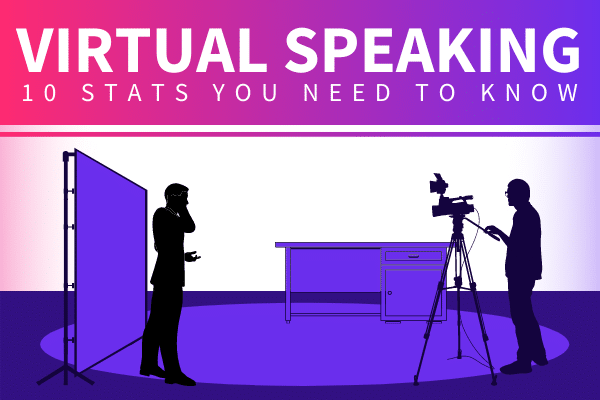As the industry shifts towards virtual events, I’m sure you’re facing many of the same challenges we are, here at SpeakerFlow. You might be asking questions like, “How do I know how much to charge for virtual speaking?” or “How are others in the industry adapting?” You also might be venturing into the world of virtual events for the first time and simply at a loss for how to best move forward.
Thankfully, you – and all of us in the industry – are far from alone. Whether you’re well-versed in virtual events or just picking them up, every one of us is working through a time of new and demanding challenges. However, this is also a time of growth, and expanding your knowledge now will better prepare you for the future.
To help with that growth, we’ve pulled together ten virtual speaking statistics that you absolutely need to know. These stats originate from a July 2020 survey of 476 event planners and 212 suppliers, conducted by the Professional Convention Management Association (PCMA). Of these participants, roughly 84% of each group operates in North America (namely the U.S and Canada). Altogether, the survey also includes insights from planners and suppliers in Asia, Europe, and Latin America.
From these statistics, we can not only see the current state of the industry. We can also predict many upcoming opportunities, allowing us to structure our business goals and processes accordingly.
With that in mind, let’s dive in! 🎉
53% of event planners have at least one event they’re transitioning to a virtual format in the next few months.
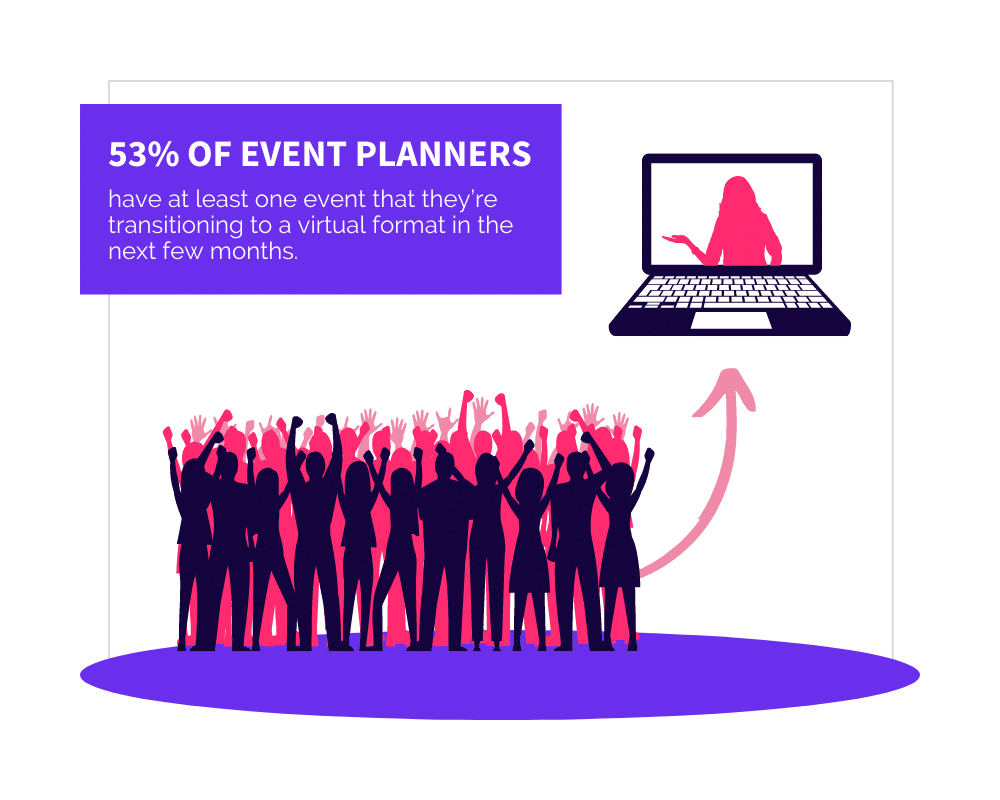
First and foremost, let’s talk about live events. At the beginning of 2020, for many event organizers, transitioning a live event to a virtual setting was unthinkable. Many feared the necessary technology was too complicated, the event attendees wouldn’t feel like they were getting their money’s worth, or that they wouldn’t have enough time to craft a well-structured event.
Over time, however, many of those fears have been calmed. Everyone from government leaders to celebrities to television personalities has adopted a virtual format as a way to carry on with their lives and their professions when live events simply aren’t safe. In the events industry, specifically, speakers and event organizers have demonstrated that virtual speaking can be just as impactful as a live event.
Now, more than halfway through the year, 53% of event planners say they have at least one event that they’re transitioning to a 100% virtual format in the next few months. Another 26% say that they are including digital components, even if other aspects of the event are live. In this way, event attendees can still gain insights from the event. Plus, event organizers and speakers can still get paid, even if they’re operating from home.
The Takeaway:
Although much of the shift towards virtual speaking was inevitable, these responses show resiliency that is incredibly important to note. Are event organizers throwing in the towel on all their events? Are they telling speakers they previously hired that they have to break their contracts? Sure, some of them are! But, most of them are instead adapting to the situation and embracing virtual events as best as they can. Consequently, if you’re looking for speaking opportunities in the near future, your best bet is to do the same.
37% of event planners cite hybrid event budgeting as their greatest financial challenge.
That said, although many planners are seeing virtual events as the way forward, new mediums always come with new challenges. In the context of events, this is especially true because of the number of factors to keep in mind. I’m talking the technology for the event, making sure everyone on the team knows how to use basic video conferencing tools (like Zoom), and that online communication between event organizers and speakers is streamlined. Between preparing for the event and making sure it runs smoothly once it begins, there are just as many challenges for a virtual event as there are for a live one.
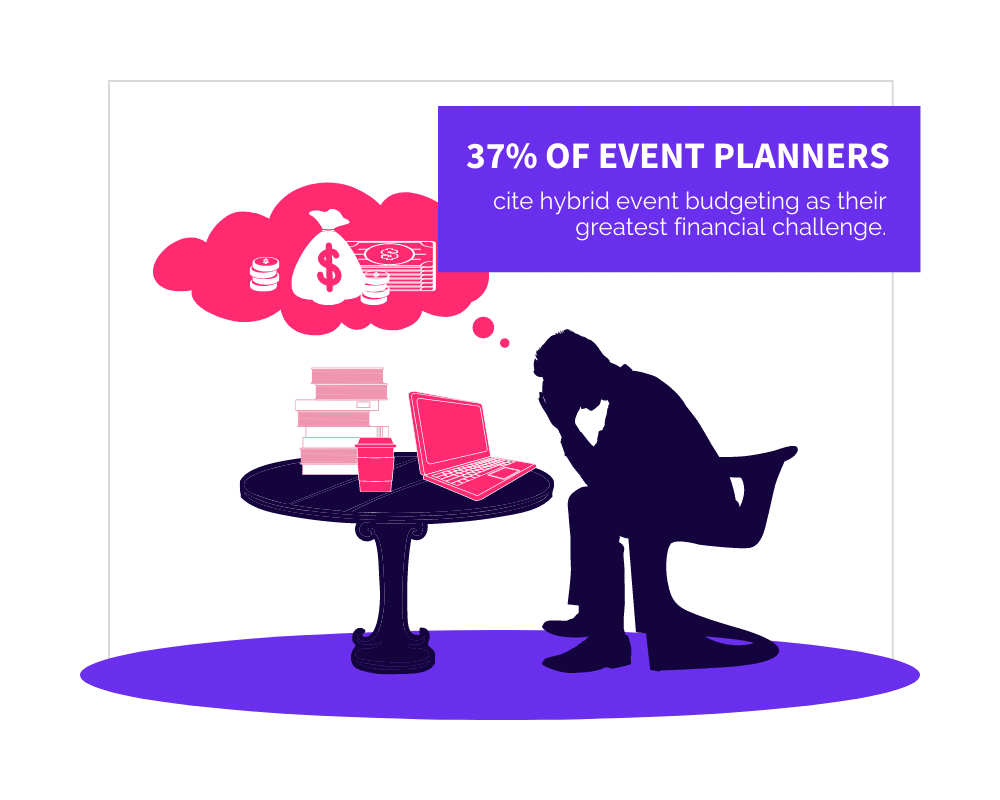
Unsurprisingly, one of the biggest challenges of virtual event management is money. In fact, according to the PCMA’s survey participants, 37% cite budgeting as their biggest financial challenge for hybrid events. How much should it cost for a speaker? What about event technology? Should I include extra resources to compensate for the virtual format? Because there’s no physical venue or in-person engagement, it can be hard to know how much money is too much.
It can also be difficult to estimate an appropriate range of prices for event speakers. According to John Truran, senior vice president of Keppler Speakers, for example, price can vary greatly. He states, “In general, speaker fees for virtual appearances are 25 to 50 percent lower. However, some speakers are choosing not to reduce their fees at all, so this is not an across-the-board change.”
The Takeaway:
Because there’s no defined “playbook” for virtual speaking, the key thing to keep in mind is flexibility. When selling to virtual event organizers, turn your focus on them to learn how you can best serve their audience. Ask questions like, “What are you hoping to achieve at this event compared to one of your live events?” and “What are some concerns you have about virtual speaking compared to live events?” With any questions, the more you know, the more easily you’ll be able to prove you can help. Additionally, if they mention concerns around price, you’ll be able to position yourself as an authority in the virtual speaking space. That lets you bargain for higher fees, even if you earn less than you would for a live event. 💰
56% of event planners include diversity goals in their speaker hiring process.
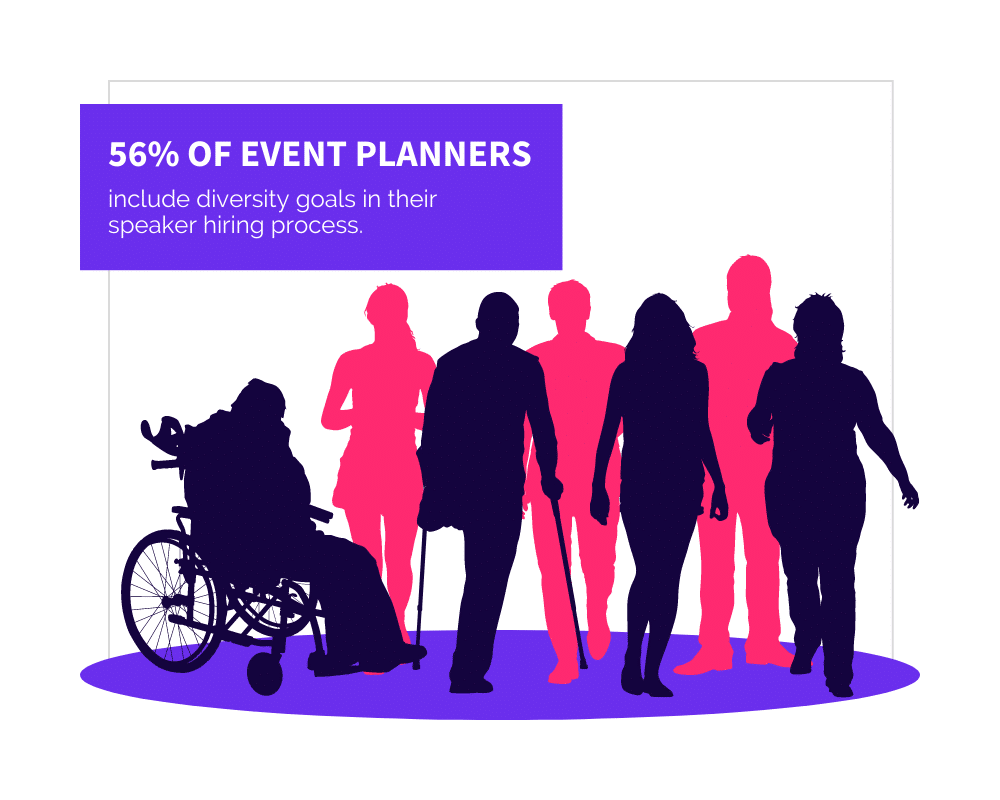
In addition to pricing, another factor of virtual speaking to keep in mind is diversity. Although 2020 has been notable for many reasons, diversity and equity have been widely-covered topics (and with good reason). This is especially true within the United States, where the topics of race, ethnicity, gender, and sexual orientation are still widely debated in professional and political settings.
As these debates have intensified in recent years, many industries have adopted diversity pledges, the speaking industry included. Today, when choosing a speaker, 56% of event planners say they include diversity goals in their hiring process. This means that these organizers strive to seek out and consider speakers from a diverse range of backgrounds. It also means, in terms of race, ethnicity, gender, and sexual orientation, they try to hire a balance of speakers. That way, audience members are better represented and exposed to a wider range of experiences, viewpoints, arguments, and suggestions.
Outside of major events, organizers for company events are also increasingly focused on diversity, as 69% of company executives consider it to be a priority and diverse teams are more likely to see increases in profitability year over year. That’s a lot of incentive for planners and executives to highlight diversity, aside from the humanitarian reasons to do so.
78% of event planners set diversity goals around gender when planning events. 80% set goals around ethnicity.
Within the context of diversity, it’s also important to note the areas of diversity kept in mind. In the last section, I mentioned four areas of diversity that event organizers focus on when hiring for virtual speaking events. However, of those areas, some are given more weight than others.
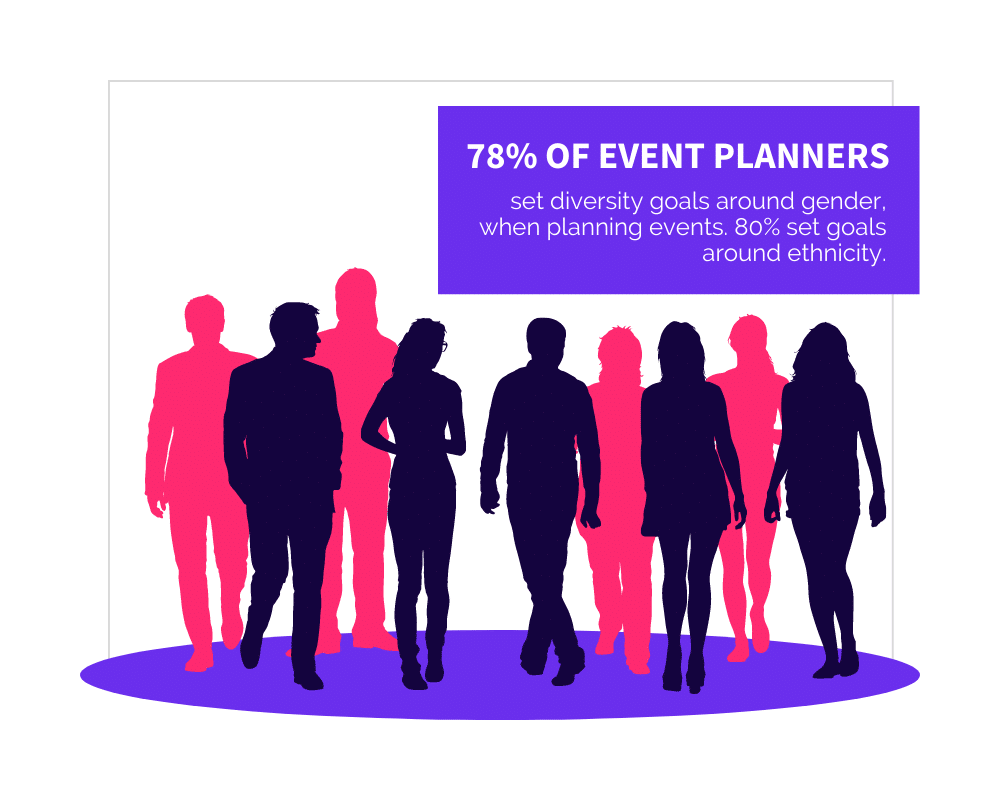
For instance, over the last several decades, the topic of gender diversity and equality has been greatly promoted. Because of this, the pay gap between male and female employees has dramatically decreased. In fact, a study by Glassdoor at the beginning of 2020 found that “U.S. workers ages 18 to 24 years see an adjusted gender pay gap of 1.4%, compared to workers ages 55 to 64 years, who face an adjusted gender pay gap of 12.3%.” If a difference that great doesn’t show the importance of diversity, I don’t know what does!
Unfortunately, in many cases, the other areas of diversity – race, ethnicity, and sexual orientation – have been considered less urgent. Among speakers, a 2019 Harvard Business Review article by Ruchika Tulshyan outlined the issue of racial diversity. In it, Tulshyan argued:
There has been lots of talk in the past few years about all-male panels, fondly dubbed “manels,” and why they are problematic… However, less attention has been paid to how too many events also lack racial diversity. We know diversity in teams unlocks innovation and makes us smarter. So I’m routinely surprised at the reluctance of conference organizers to prioritize this.
Fortunately, in the PCMA’s June survey, there’s considerable evidence that this may be finally changing. In the survey, 78% of event planners said they include gender in their diversity goals. But, of those planners, 80% also include ethnicity and almost 40% include sexual orientation.
The Takeaway:
Ultimately, all attention to diversity in virtual speaking is a good thing. Yet, this year, especially, it’s also clear that it has to be a “team effort,” if you will. We can’t simply rely on event organizers to make sure the speaking industry reflects the diversity of our global profession. We each have to play an active role, whether you’re a speaker, salesperson, or support team member (like me!). 🙂
To do this, Tulshyan (herself a keynote speaker) recommends eight practices to adopt, some for event planners, some for speakers. Below are three of my favorites, summarized.
- Pay it forward. If you identify as a cisgender white person and frequently receive speaking requests, take the opportunity to recommend other underrepresented speakers within your area of expertise.
- Support diverse companies and events. Not everyone is in a position to be selective about their speaking opportunities. However, if you are, make a point to support those that champion diversity (and hire a diverse range of speakers).
- Support speakers in underrepresented groups outside of events. Speaking organizations can be just as lacking in diversity as those in any other industry. When networking, look for speaker organizations that prioritize diversity among speakers.
56% of event planners do not track the demographic information of their participants.
At this point, we’ve covered two significant areas of the PCMA’s survey: the shift to virtual speaking and diversity goals. Now, let’s cover data, one of the SpeakerFlow team’s favorite topics.
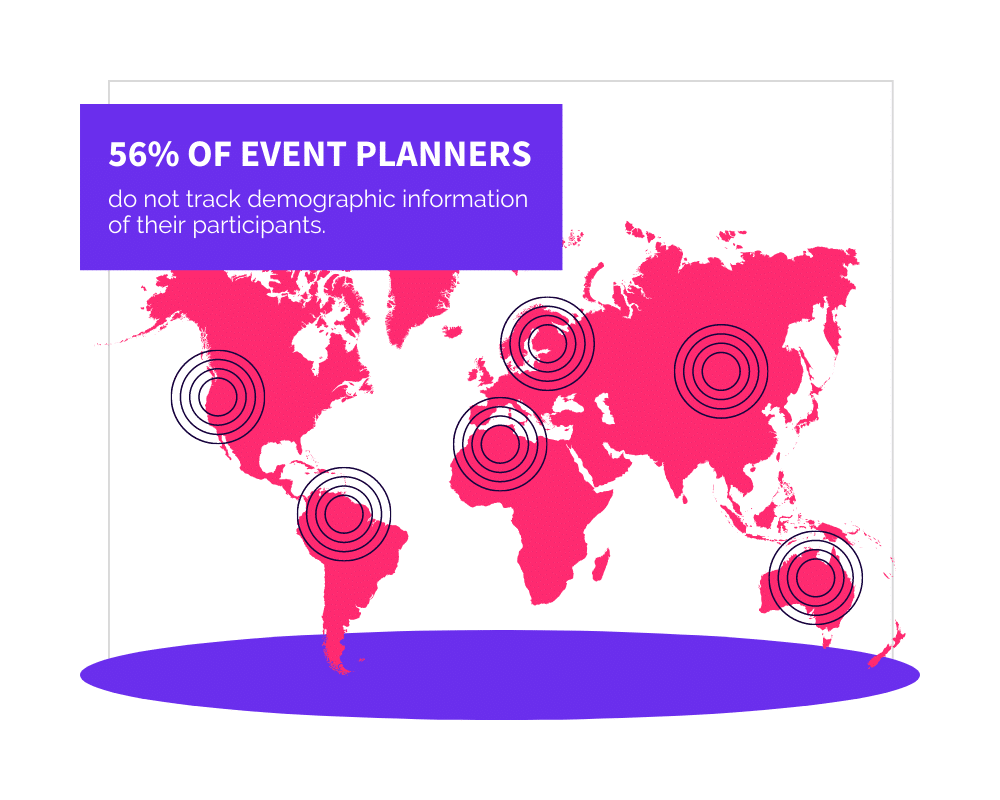
Whether you’re considering sales, operations, or marketing in your speaking business, we recommend to “drive with data.” In sales, this can mean tracking which industries hire you most or planning revenue goals for each month, quarter, and year. In marketing, on the other hand, this can mean tracking where your organic leads are coming from (i.e. the people that seek you out rather than the other way around) or keeping a count of your social media followers. Whatever business component you’re looking at, the point of data is to give you insights into where you could improve.
Unfortunately, throughout the speaking industry, there are many cases in which no one collects data in the first place. In the PCMA’s survey, for instance, many event planners admitted to a lack of data collection, especially in the aforementioned areas of diversity. When asked if they track gender and ethnicity demographics of their attendees for face-to-face events, 40% and 17% said “yes,” respectively.
Additionally, when asked, “Do you have data that shows that your virtual event is attracting a more diverse audience in terms of race, gender, and nationality?” only 8% said they did while an overwhelming majority said they either did not (56%) or they simply didn’t know (36%).
The Takeaway:
Although the majority of event planners say they set diversity goals for their speakers, this data – or lack thereof – shows that many don’t check that their goals align with their audience. For example, if an event planner sets gender diversity goals for their speakers but doesn’t track the gender demographics for their audience, they could end up hiring a speaker their audience can’t relate to (even if they generally appreciate the presentation). The same is true for ethnicity, sexual orientation, age, etc.
In short, while data collection is a valuable tool in all areas of a speaking business, it’s undeniably important when it comes to sales. If you know what your audience is like, you can more easily craft an effective presentation. From there, if you and your client know what the audience is like, you can work together to ensure the event’s impact continues long after the presentation is over.
For your future clients, ask if they are collecting any pre-event information about their attendees. If they are, build a presentation plan with them, so you know you’ll have an impact and they know you’re invested in their success. If they aren’t collecting any data, be the first speaker to suggest that they do! The more data you have, the more specific and powerful your presentation will be. The better your presentation, the more likely you’ll receive referrals or a request for a second virtual speaking opportunity.
34% of event suppliers expect a 51-75% decline in the events industry for 2021.
Speaking of future clients, one aspect of the speaking industry we haven’t yet covered is the idea of competition. In many ways, live and virtual speaking is unique because the competition isn’t as cut-and-dry as in other industries. Because every speaker is unique in their background, their message, or their stage presence, every speaker can argue that their own individuality sets them apart.
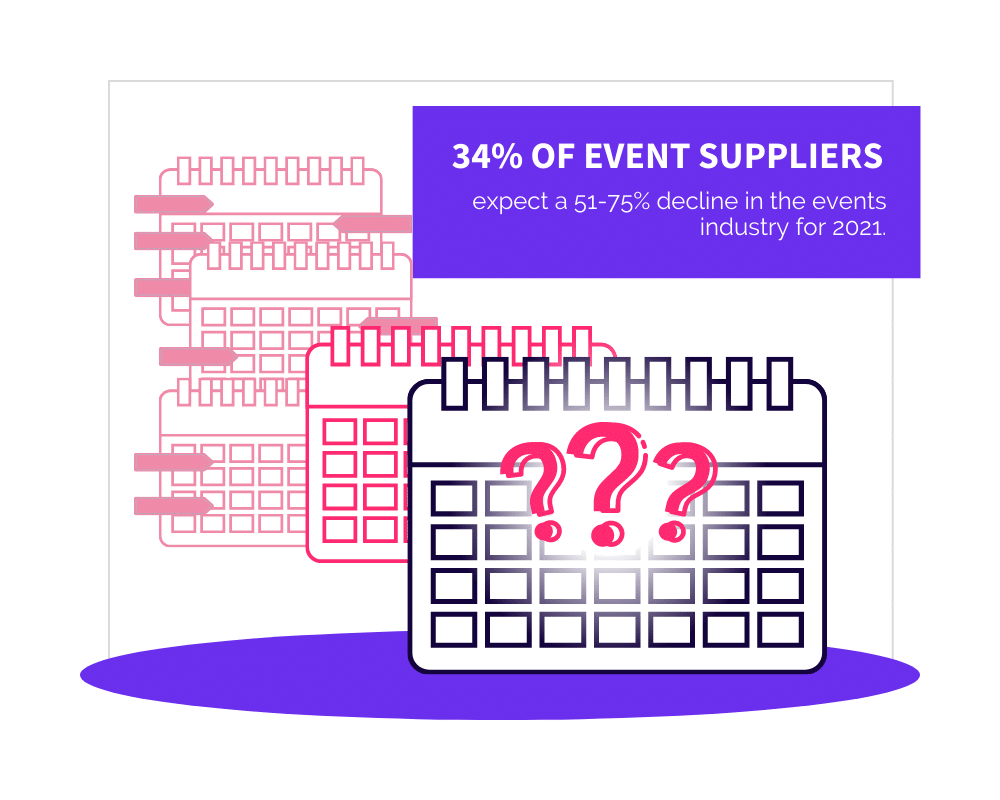
Or, at least they could until the beginning of 2020. As the COVID-19 pandemic emerged in January 2020, many planners canceled their pre-planned events. Even now, as the year winds down, in-person events are still few and far between. Looking ahead, in the PCMA’s July survey, 34% of event suppliers say they “expect the pandemic’s economic fallout to have a more lasting effect” with a projected 51-75% decline in the events industry for 2021.
In other words, although each speaker is still unique in their own way, the number of opportunities has shrunk while the number of available speakers remains the same, making the competition stiffer than it’s ever been before. To put it bluntly, the world of speaking isn’t just shifting towards a more technologically-reliant future. It’s also largely weeding out speakers that can’t adapt and, by extension, can’t compete with their fellow speakers.
The Takeaway:
That said, as scary as this sounds, there are plenty of ways to avoid the “weeded out” group. For one thing, virtual speaking is still, in many ways, uncharted territory. Many event organizers are new to it entirely and, consequently, don’t have a ton of expectations for their virtual event. They just want it to be smooth, impactful, and revenue-earning, so they can bounce back from the beginning of 2020.
As a speaker, this provides you with an opportunity not just to motivate and engage their audience but also to blow their mind, when it comes to virtual events. When pitching your services, be confident and demonstrate that, even if they’ve never hosted a virtual event, you’ll help them succeed. When delivering your presentation, go above and beyond to build energy and engagement in your audience so that, even though they may have their phone next to them, they don’t want to look away.
In short, from your studio setup to your presentation style to your post-event resources, every virtual speaking event is a chance for you to set the bar high for whoever comes after you. To maximize this chance and hit the ground running in your next virtual event, check out our previous guides to exceptional virtual speaking and virtual keynote presentations. 👍
20% of event planners and 35% of suppliers expect a 51-75% decrease in revenue for the next year.
Next, let’s tackle another topic on everyone’s minds right now: income. For many speakers and event organizers alike, the beginning of 2020 was rough. Events were canceled, attendees were refunded, and speaking contracts were frozen, resulting in a huge revenue loss for everyone involved. The New York Times even compiled a list of major events canceled in sports, music, and entertainment across the U.S., commenting on the huge scale of revenue lost because of the cancellations, collectively.
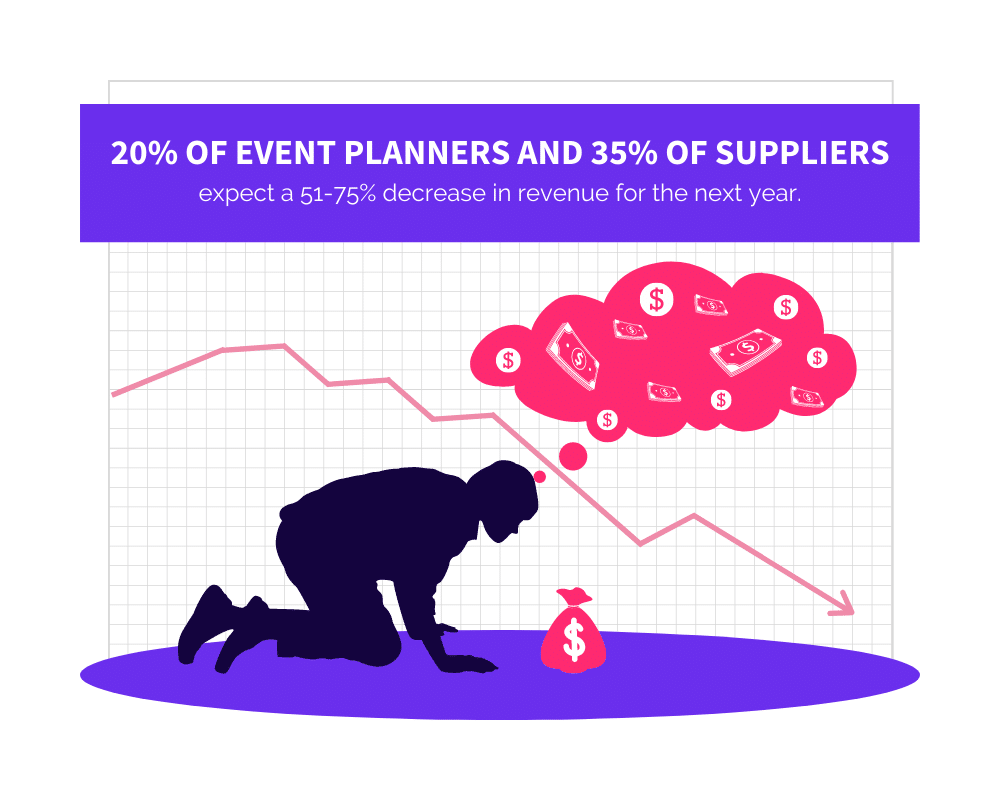
In the speaking industry, although the loss may be smaller than that of sports or television, it’s no less damaging. Previously, I mentioned event planners’ predictions for 2021 event frequency. However, it’s also important to note the resulting budgetary changes. After all, fewer events in 2020 means less revenue for the beginning of 2021. Less revenue for 2021 means a smaller percentage of the budget available for speaking engagements.
According to many event planners, that budget may even be drastically smaller than originally expected. At this time, 20% of planners and 35% of suppliers say they expect a 51-75% decline in revenues in 2021. They also say the decline for fall 2020 (compared to this time in 2019) may be even greater than 75%. That’s a dramatic decrease, even with the potential for virtual events in the coming months.
The Takeaway:
Because of this decrease, it’s of the utmost importance – again – that we remember we’re all in this together. Speakers may be struggling to make ends meet, but so are event planners. Companies may be concerned about pre-planned events for their team, but so are the suppliers that earn from those events.
In short, everyone is tight on revenue at the moment and likely stressed at the industry changes. Consequently, event planners aren’t just looking for speakers that can rise above the increased competition among speakers. They also want speakers that empathize with planners and understand that, for reasons outside of event planners’ control, speaking fees often must be smaller than is ideal.
However, according to one of our CEO, Taylorr Payne, this doesn’t mean you have to speak for free. You just have to be flexible! When asked how to do this, Taylorr recommended the following:
The “money conversation” right now is a little like the wild, wild, west, but we are coaching folks that they can expect 40% to 60% less for a virtual event than for a live one. I do believe, however, there needs to be a floor (I’ve heard most people say no less than $2500). I would encourage speakers to decide what they want to get paid and be prepared to educate meeting planners and other folks who are hiring. Most of the people hiring do not have a plan, and this is so new to all of us that meeting planners and executive directors are trying to figure it out, too.
In other words, be flexible but don’t sell yourself short, either. Your time is still valuable and worth compensation. Just remember that compensation can’t always be as generous as in the past.
41% of event planners and 27% of suppliers say they would not travel for an event within the next year.
At this point, you might be asking, “This is great, but why would I learn virtual speaking when I could just wait for live events to return?” And that’s a fair question! But the answer to that question is a little more complicated than you think.
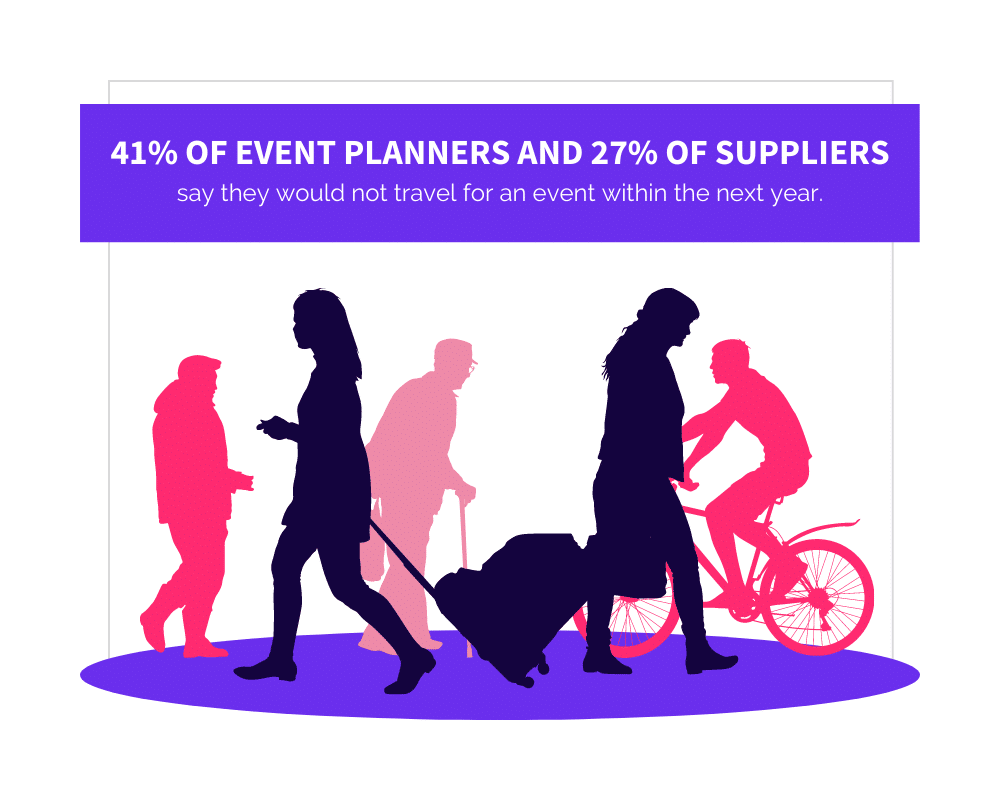
For starters, while some regions around the world are reopening for small events, large events are still up for debate. In the U.S., for example, the New York Times interviewed 511 epidemiologists and infectious disease specialists to ask which day-to-day activities they consider safe (i.e. safe without sanitization precautions). Some of these activities were deemed safe as of right now, including “bring in the mail” and “see a doctor for a nonurgent appointment”. However, others, like “attend a religious service” or “attend a sporting event, concert or play” were projected to be unsafe through the end of 2021.
Likewise, in the speaking industry, large live events aren’t likely to become the norm again for some time. This is mainly due to the fact that travel (especially via airplanes) comes with increased health risks, leading many to be reluctant to travel in the immediate future. In the PCMA survey, specifically, one question asked, “In the absence of therapeutic treatment or vaccine for the COVID-19 virus, what is the farthest distance from your home you would consider traveling to a business event in 2020, assuming there are no financial or regulatory restrictions on travel?” In response, 41% of event planners and 27% of suppliers said they would not travel at all. Another 22% of planners and 27% of suppliers said they would travel but only if the program was within a four-hour driving distance.
The Takeaway:
Considering these stats, planning for virtual speaking engagements isn’t just a sure way to make it through 2020. It’s an inevitability for any speaker that wants to prepare for similar challenges in the future.
Looking back, in the U.S. alone, for instance, there have been roughly five health crises considered to be pandemics by the Centers for Disease Control & Prevention (CDC) over the last hundred years, not including the relatively recent appearance of COVID-19. Some were relatively short while others have yet to conclude. Nevertheless, all of them demonstrated the high likelihood of periodic public crises and the resulting importance of adaptation. In today’s crisis, that’s where virtual speaking comes in!
Although it can be daunting to move forward, live events aren’t coming back anytime soon. For the being, virtual speaking is safest. Plus, in many cases, it offers a way for typically disadvantaged companies to host an event when they wouldn’t ordinarily be able to do so.
Below are just a few examples in which virtual speaking is preferable to a live event, to inspire you (besides the fact that you can answer Zoom calls in your pajama bottoms). 😜
- Speaking for small remote teams looking for a low-cost way to host an event
- Speaking for companies in areas with harsh weather, like Minnesota (Fun fact: Minnesota routinely hits temperatures below -40°F in winter. Talk about cold!)
- Motivating teams during economically challenging or uncertain times, such as public health crises or recessions
- Speaking for international audiences without the added time and cost of travel
60% of event planners predict that small in-person or hybrid events will be most common in 2021.
Besides completely virtual events, another option for 2020 and beyond is hybrid events. As the name suggests, these events include in-person and virtual components rather than solely one or the other. In a recent Bizzabo blog, for example, one hybrid event included an in-person gathering in San Francisco, CA accompanied by live-streamed keynotes and breakout sessions to a worldwide audience. Another example was HubSpot’s annual INBOUND event, which combines business expertise, entertainment, and networking in a multi-day live and virtual event.
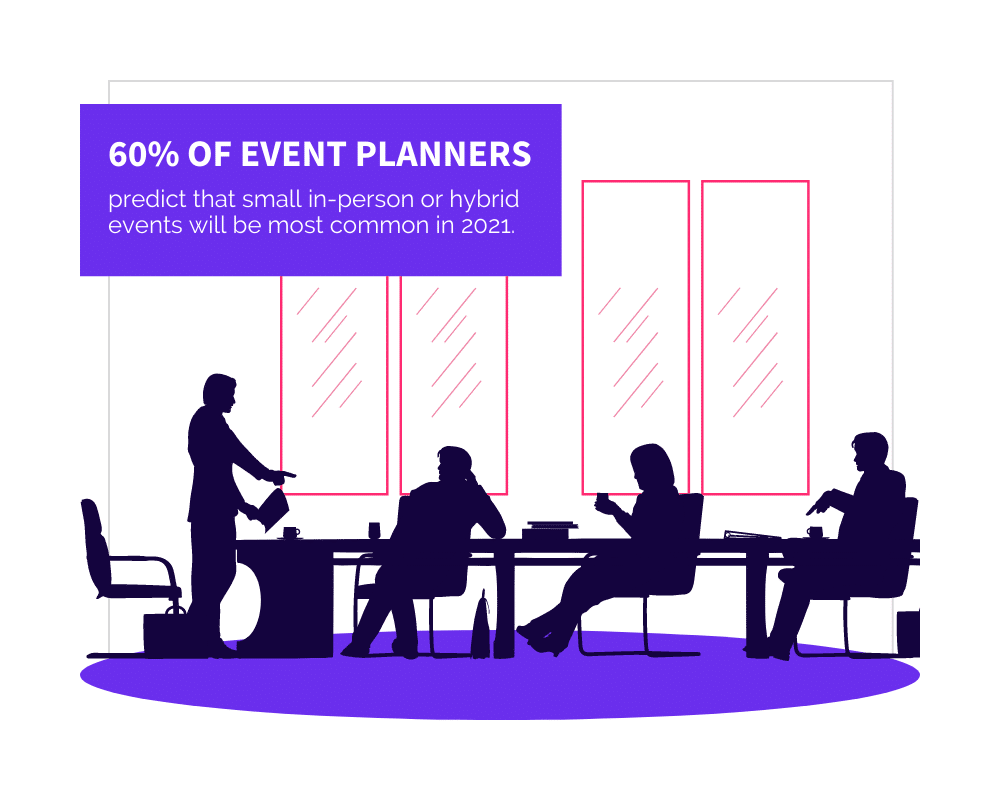
Either way, the main thing to note is that unlike virtual speaking, hybrid events have been around for decades. They’re also increasingly popular for attendees and event hosts alike for a number of reasons, including better ROI for event organizers and greater accessibility for attendees, as the hybrid components can be available worldwide.
Because of these benefits, hybrid events are also projected to be the segway back into live events, as we head into 2021. According to PCMA survey participants, for instance, when asked “When the pandemic crisis passes, what scenario do you think best describes the recovery of face-to-face meetings for the business events industry in your geographic region?” 27% answered that “Small in-person events will be hybrid, with a digital version for a larger audience.” On top of that, another 33% predicted that “Smaller local and regional events will thrive before national and international groups gather.”
The Takeaway:
In other words, throughout the coming months, small events are likely to become more frequent. However, providing a hybrid component (i.e. adding a virtual speaking aspect to the event) is an easy way for event planners to boost their event revenue while keeping things relatively small and safe.
Additionally, as a speaker, selling to hybrid event planners allows you to boost the value of their event in a single contract. If they’re worried about the event kickoff, you can do a live-streamed keynote. If they’re anxious that a hybrid event won’t have the same long-term impact of a live event, you can offer workbooks, consulting, or group coaching to help. Essentially, think of hybrid events as a way for you to flex your virtual speaking muscles while still having a chance to make close to your standard speaking fee. That way, event planners can more easily segway back into live events, and, when they do, they’ll remember how awesome you were and hire you again.
71% of event planners and 58% of suppliers say they need to put more effort into crafting digital experiences.
Finally, the last important statistic to note relates to the overwhelming idea of this blog: community. As we move forward, the vast majority of us are jumping into projects, techniques, or systems that are entirely new. In some cases, we’re even building them from the ground up, as there isn’t a playbook for how to navigate a world without live events when the majority of your business is through live events. We know! We feel stressed and anxious, too!
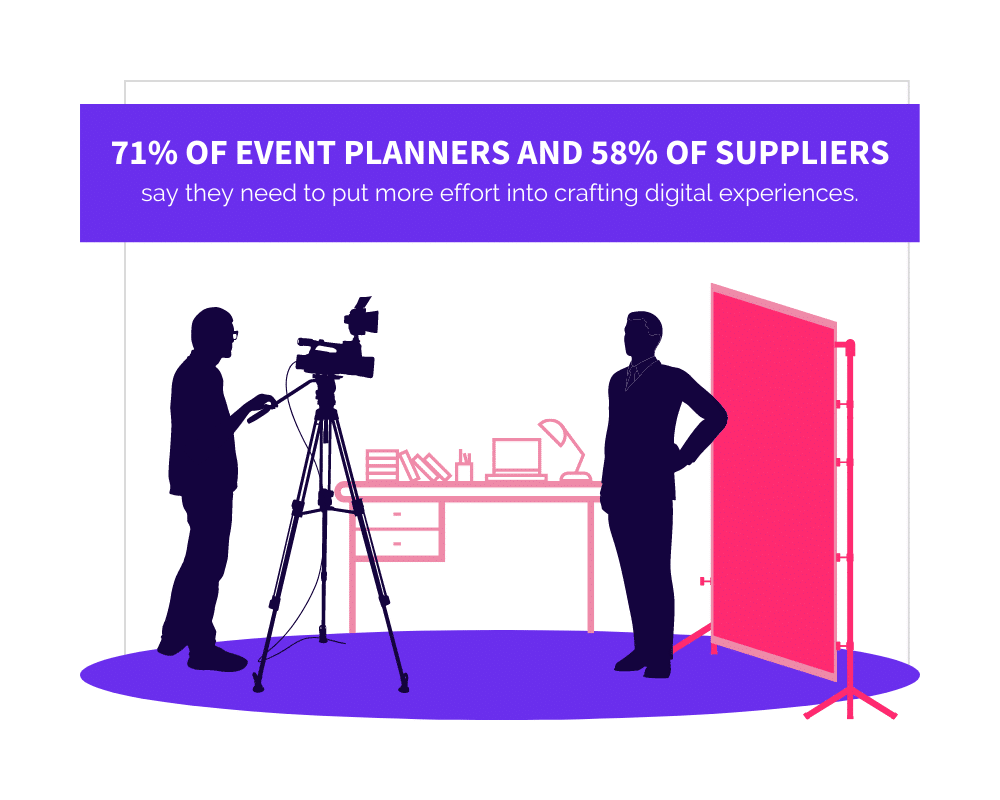
But, if we’re going to be more prepared for the future, rather than dwelling on what was, it’s time to ask, “What can I do now to best handle this situation?” and “What do I have to learn in the immediate and near future?”
In the PCMA’s July survey, event planners and suppliers received a similar question, namely “In order to prepare professionally for success in the business events industry during the recovery, which new skills do you think you need to pursue/develop?” In response, the vast majority – 52% of planners and 54% of suppliers – said they needed to devote more energy to “designing live experiences in post-COVID-19 physical environments with more stringent hygiene standards.”
Likewise, 71% of planners and 58% of suppliers said they planned to invest more time and energy into “designing digital event experiences,” and 35% of planners and 65% of suppliers said they needed to develop new sales and marketing approaches, suited to a post-COVID-19 market. Other respondents also mentioned audience engagement and structure for hybrid events as additional concerns.
The Takeaway:
Among all of the responses, however, one respondent said it best, when asked how they’re heading into the future, stating:
Until a vaccine is discovered, produced at scale, and widely distributed, live indoor events are at high risk of failure, even with enhanced on-site safety protocols, which, in my opinion, will turn people off from attending. (Who really wants to enter a trade show where staff and suppliers all look like frontline ICU workers? I certainly don’t and neither do most people I’ve asked.) Hence, understanding and educating oneself with virtual opportunities should be a priority during the recovery period because that’s where the action is going to be in the events world.
Summarily, as we head into 2021, remember you’re not in this alone. Virtual speaking is new to all of us, and, in many cases, event planners and suppliers are just as tentative as you might be, reading this. However, in the long run, this is an opportunity for growth, and whether or not you grow in the coming months depends largely on whether or not you adapt now.
With that in mind, hopefully, these stats (and the insights and resources sprinkled throughout them) have given you some confidence and motivation to jump into the world of virtual speaking! For more hands-on guidance or to discuss other industry insights, feel free to schedule a free call with our team, and remember: we’re all in this together. 👍
Note: Due to the publication date of this blog, we recommend taking advantage of additional industry resources, including SpeakerFlow’s free resource library or community, so that you have the most recent data available. For more information from the PCMA specifically, check out their August 2020 rendition of the survey studied in this blog.


